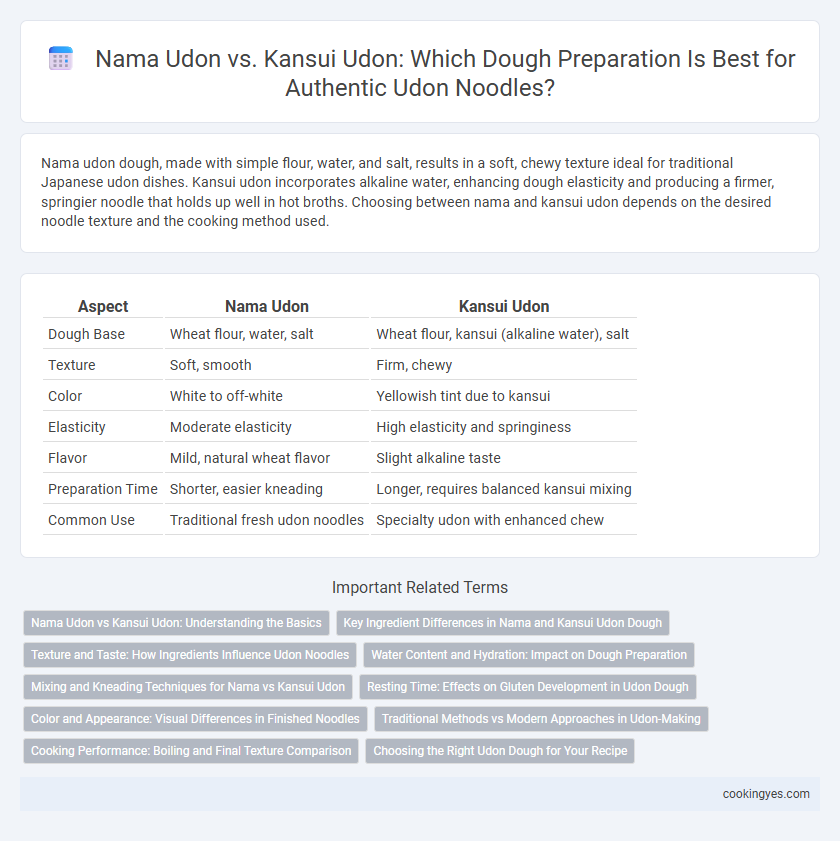Nama udon dough, made with simple flour, water, and salt, results in a soft, chewy texture ideal for traditional Japanese udon dishes. Kansui udon incorporates alkaline water, enhancing dough elasticity and producing a firmer, springier noodle that holds up well in hot broths. Choosing between nama and kansui udon depends on the desired noodle texture and the cooking method used.
Table of Comparison
| Aspect | Nama Udon | Kansui Udon |
|---|---|---|
| Dough Base | Wheat flour, water, salt | Wheat flour, kansui (alkaline water), salt |
| Texture | Soft, smooth | Firm, chewy |
| Color | White to off-white | Yellowish tint due to kansui |
| Elasticity | Moderate elasticity | High elasticity and springiness |
| Flavor | Mild, natural wheat flavor | Slight alkaline taste |
| Preparation Time | Shorter, easier kneading | Longer, requires balanced kansui mixing |
| Common Use | Traditional fresh udon noodles | Specialty udon with enhanced chew |
Nama Udon vs Kansui Udon: Understanding the Basics
Nama udon dough is traditionally made with only wheat flour, water, and salt, resulting in a soft and chewy texture prized in Japanese cuisine. Kansui udon incorporates alkaline water (kansui), which increases dough elasticity and firmness, producing a slightly yellow hue and a firmer bite distinct from nama udon. Understanding these differences guides chefs in selecting the ideal udon type for specific culinary applications, balancing texture and flavor preferences.
Key Ingredient Differences in Nama and Kansui Udon Dough
Nama udon dough primarily uses fresh wheat flour and water, creating a soft and chewy texture, while Kansui udon incorporates alkaline water (kansui), which contains potassium carbonate and sodium carbonate to enhance elasticity and give a slightly yellow hue. The alkaline ions in Kansui udon strengthen gluten networks, resulting in firmer noodles that retain shape better during cooking. Key ingredient differences significantly impact the texture, color, and cooking properties between Nama and Kansui udon varieties.
Texture and Taste: How Ingredients Influence Udon Noodles
Nama udon utilizes fresh wheat flour and water, resulting in a soft, chewy texture with a subtly sweet flavor that highlights the dough's freshness. Kansui udon incorporates alkaline water containing sodium carbonate and potassium carbonate, which enhances the noodle's elasticity and firmness while imparting a distinct umami taste and slightly yellow hue. The choice between nama udon and kansui udon ingredients directly affects the noodle's mouthfeel and flavor profile, making them suited for different culinary applications.
Water Content and Hydration: Impact on Dough Preparation
Nama udon dough typically contains higher water content, resulting in increased hydration that produces a softer, more pliable texture ideal for fresh udon noodles. In contrast, Kansui udon incorporates alkaline water with lower hydration levels, which strengthens the gluten network and yields firmer, chewier noodles. The distinct water composition and hydration ratios critically influence the dough's elasticity, firmness, and overall noodle quality in udon preparation.
Mixing and Kneading Techniques for Nama vs Kansui Udon
Nama udon dough requires gentle mixing and extended kneading to develop gluten evenly and retain moisture, ensuring a tender and chewy texture. Kansui udon dough incorporates alkaline water, demanding firm mixing and vigorous kneading to activate the alkaline's effect on protein structure, resulting in a firmer, springier noodle. Precise control of kneading time and pressure is crucial for both, influencing the final udon noodle's elasticity and bite quality.
Resting Time: Effects on Gluten Development in Udon Dough
Nama udon dough requires a longer resting time, typically around 30 to 60 minutes, to allow sufficient gluten development for a chewy texture essential in fresh udon noodles. In contrast, kansui udon, which incorporates alkaline water, often benefits from a shorter resting period of 15 to 30 minutes due to chemical interactions that promote rapid gluten formation and dough elasticity. Proper resting time directly influences gluten network strength, affecting udon's firmness, bite, and overall mouthfeel.
Color and Appearance: Visual Differences in Finished Noodles
Nama udon dough exhibits a pale, creamy white color due to the use of fresh wheat flour and minimal additives, resulting in a soft and smooth texture that reflects light gently on the finished noodles. Kansui udon incorporates alkaline water, imparting a slightly yellowish hue and a firmer, glossier surface that enhances noodle elasticity and chewiness. The visual contrast between the creamy softness of nama udon and the shiny, yellow-toned kansui udon highlights their distinct preparation methods and influences consumer preference based on appearance.
Traditional Methods vs Modern Approaches in Udon-Making
Nama udon dough, traditionally prepared with fresh wheat flour and water, emphasizes a soft texture and elasticity achieved through resting and hand-kneading, reflecting time-honored Japanese culinary techniques. Kansui udon incorporates alkaline mineral water, which modernizes the dough by enhancing gluten development and firmness, resulting in a chewier texture favored in contemporary udon production. Balancing these methods affects not only the noodle's bite and color but also its suitability for diverse regional udon styles and cooking applications.
Cooking Performance: Boiling and Final Texture Comparison
Nama udon dough, made with fresh wheat flour and water, exhibits superior elasticity and smoothness during boiling, resulting in a tender yet chewy texture ideal for traditional Japanese dishes. Kansui udon dough incorporates alkaline water, enhancing the dough's firmness and providing a slightly firmer bite with a distinct yellow hue, which holds up well in hot soup applications. The boiling process for nama udon typically yields a softer, silkier noodle, whereas kansui udon retains more resilience and a springier texture, catering to different culinary preferences and cooking methods.
Choosing the Right Udon Dough for Your Recipe
Nama udon dough, made from wheat flour, water, and salt, offers a soft, chewy texture ideal for fresh, delicate udon dishes. Kansui udon incorporates alkaline water, enhancing elasticity and giving the noodles a firmer bite, perfect for stir-fried or soup-based recipes requiring resilience. Selecting between nama and kansui udon dough depends on the desired texture and cooking method of your udon recipe.
Nama udon vs Kansui udon for dough preparation Infographic

 cookingyes.com
cookingyes.com